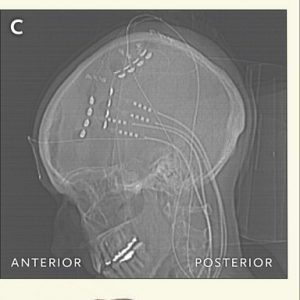Wireless Brain Implant Allows “Locked-In” Woman to Communicate
Experts call the technology a “significant achievement,” but critics say the risks may not be justified.
SAN DIEGO—A wireless device that decodes brain waves has enabled a woman paralyzed by locked-in syndrome to communicate from the comfort of her home, researchers announced this week at the annual meeting of the Society for Neuroscience.
The 59-year-old patient, who prefers to remain anonymous but goes by the initials HB, is “trapped” inside her own body, with full mental acuity but completely paralyzed by a disease that struck in 2008 and attacked the neurons that make her muscles move. Unable to breathe on her own, a tube in her neck pumps air into her lungs and she requires round-the-clock assistance from caretakers. Thanks to the latest advance in brain–computer interfaces, however, HB has at least regained some ability to communicate.
The new wireless device enables her to select letters on a computer screen using her mind alone, spelling out words at a rate of one letter every 56 seconds, to share her thoughts. “This is a significant achievement. Other attempts on such an advanced case have failed,” says neuroscientist Andrew Schwartz of the University of Pittsburgh, who was not involved in the study, published in The New England Journal of Medicine.
HB’s mind is intact and the part of her brain that controls her bodily movements operates perfectly, but the signals from her brain no longer reach her muscles because the motor neurons that relay them have been damaged by amyotrophic lateral sclerosis (ALS), says neuroscientist Erik Aarnoutse, who designed the new device and was responsible for the technical aspects of the research. He is part of a team of physicians and scientists led by neuroscientist Nick Ramsey at Utrecht University in the Netherlands. Previously, the only way HB could communicate was via a system that uses an infrared camera to track her eye movements. But the device is awkward to set up and use for someone who cannot move, and it does not function well in many situations, such as in bright sunlight.
Devices that couple neural activity to computers have been used experimentally before to help patients with a range of neurological disorders, including locked-in syndrome. In pioneering work in 1998 neurologist Phillip Kennedy, of Neural Signals, Inc., implanted an array of electrodes into a patient’s brain who was paralyzed by a stroke to control signals in an on-off manner, and in 2015 a team of researchers led by neuroscientist Leigh Hochberg of Brown University implanted a 96-channel electrode array into the cerebral cortex of a 58-year-old woman with locked-in syndrome. Those brain implants helped patients communicate by enabling them to select words displayed on a computer screen, and similar tech has helped patients accomplish other tasks as well.
Schwartz’s team at Pitt recently demonstrated that a paralyzed man could use a robotic arm controlled by electrodes implanted in the man’s cerebral cortex to shake hands with Pres. Barack Obama. But surgically implanting electrodes into the brain carries inherent risks. “Anytime there is a wire penetrating the skin there is risk of infection,” Schwartz says, and previous attempts at brain–computer interfaces could only be performed in the laboratory because of the bulky instrumentation required. “This new study is an advance because the implant uses wireless communication with the computer. It is really important to bring this capability home, and they have done that.”
For HB, Aarnoutse and his collaborators created a simple, minimally invasive implant that she can use at home or outside to communicate using a familiar computer notebook. To achieve this,
To read the complete article see Scientific American: https://www.scientificamerican.com/article/wireless-brain-implant-allows-ldquo-locked-in-rdquo-woman-to-communicate/
 The new brain-computer interface enables HB to select letters on a computer screen using her mind alone, spelling out words at a rate of one letter every 56 seconds, to share her thoughts. Credit: Brain Center Rudolf Magnus, University Medical Center Utrecht
The new brain-computer interface enables HB to select letters on a computer screen using her mind alone, spelling out words at a rate of one letter every 56 seconds, to share her thoughts. Credit: Brain Center Rudolf Magnus, University Medical Center Utrecht
Thanks for sharing all of your experiences!